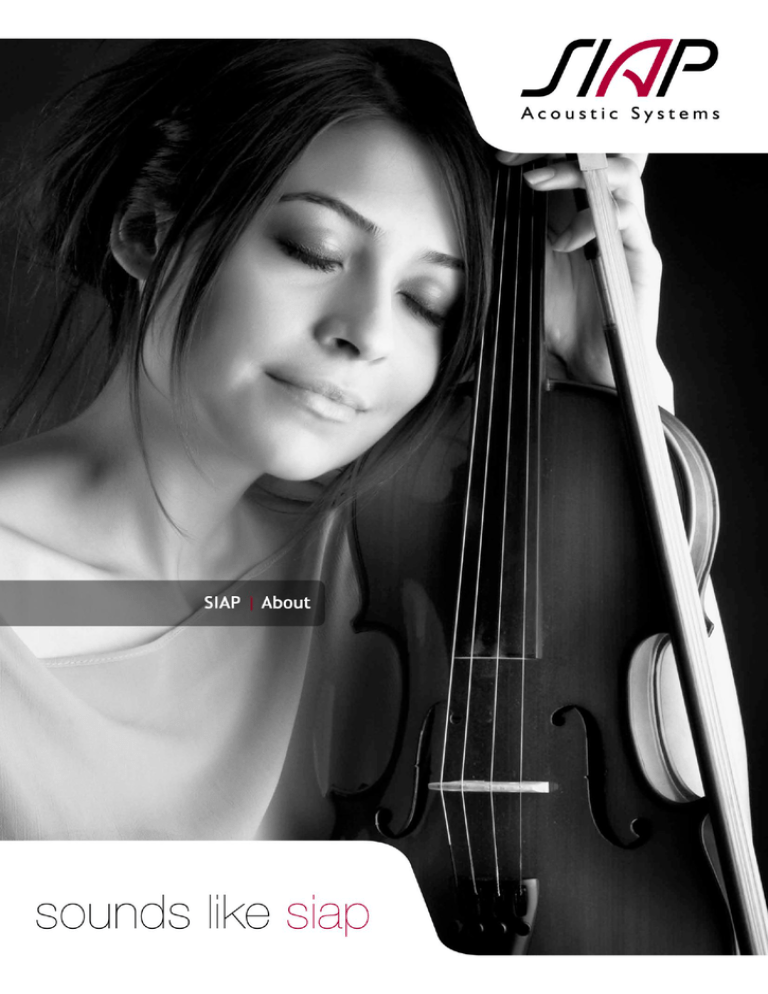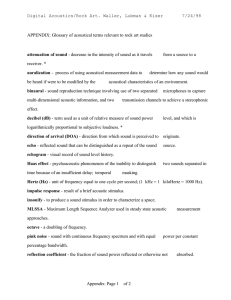Document 14627904
advertisement

SIAP | About Who are we? With more than 50 installations worldwide, SIAP Acoustic Systems B.V is a leading company in the field of auditorium and room acoustics.We – the SIAP team – wish the world – everywhere and for everyone – the happiness and joy of the best possible music experience for the ear. The maximum delight in life with which music is interconnected. For us this drive is as simple as it is seemingly self-evident. The SIAP fundament lays in our musical hearts. The team, lead by CEO’s Wim Prinssen and Reinout Gerlach, has a great passion for fine music, both in listening and performing. It’s a fundamental passion of life to combine our musical and technical talents to achieve the best possible experience of music. Translation of critical and analytical listening into acoustic architecture, results in uncompromized treatment of the music that we want to provide with optimum acoustic sound. This pure and honest principle – using only natural processes – creates a state-of-the art acoustic, that sounds like it should. Why? In 1988 a team of acousticians, dissatisfied with the commercially available (variable acoustic) enhancement systems at that time, decided to develop a System for Improved Acoustic Performance (SIAP). SIAP provides a flexible electronic architecture approach which recognizes that each performance venue has its own individual architectural acoustic signature. In 2012 (25 years later!) SIAP continues to set new standards… Our philosophy Audiences and artists are always having higher expectations regarding the sound quality of a performance or concert. After all, technology is continuously developing, as one experiences at home as well. Think only of the increasing use of surround sound in the own living environment (for example: home cinema). It’s the experience that counts. Self evident that live this has to be even better. Artists want to have justice done to their inspiration and audiences want to experience this enthusiasm at its best. Audiences and artists share the same goal, maybe even without being aware of this. Achieving such a goal may seem self evident, but it is not that in the least. Only the coming of SIAP made this reality. As it happens most venues (theatres, concert halls, auditoria etc.) are designed for one specific purpose, for example drama or for musical, opera, symphony orchestra, etc. The acoustic requirements for all these purposes are (rather) different, often even contradictory. As a consequence the same hall can only be optimally suited for a wide range of programming, if the acoustic is fully adjustable (variable acoustic) to meet the requirements of each type of performance. What is the specific aim of the SIAP system? The SIAP system is developed to create the desired natural acoustic for purpose, starting from the acoustic characteristics the hall already possesses itself. For example a theatre or playhouse usually have an acoustic that is too “dry” for music, which means to say that the sound has too little reverberation and spaciousness for that. Fortunately also in this specific field, technology is continuously going further. This need, that results from theatre practice, instigated the company SIAP Acoustic Systems B.V. a number of years ago to start developing of a ground-breaking electroacoustic technology that results in a fully variable – that is optimally adjustable to each use – acoustic. In other words, one and the same hall has a different acoustic that is adjusted to each type of performance. Additionally the SIAP system makes that the theatre sound reinforcement system can do its job perfectly well at the same time. SIAP and theatre sound reinforcement are complementary to eachother. Together both systems take care of the total synergistic sound experience. The experience gained through the systeem in many (multi)purpose halls worldwide, is of course used to further develop the system continuously (i.e. with new functionalities, the latest in the field). The strength of the SIAP system is, as it happens, the process of completing the reverberation, spaciousness etc. in natural way, in order that the system and the hall form one seamless acoustic. To say it differently, together with a SIAP system it sounds as if the hall has such a beautiful acoustic by nature for the particular performance or concert. How does SIAP works? A small number of microphones (usually four) high above the front of the stage capture the sound. Feed the stage sound of the performers, orchestra, choir etc. with all of its information such as source location(s) and their tonal quality to the SIAP acoustic processor. The SIAP processor is a very powerful sound processing “system”. In this the sound is treated with appropriate time delays, filters and reverberation fine-structure based on the desired acoustic. For this purpose the processor comprises a large number of independently programmable channels, the output sound of which is reproduced in the hall through high quality power amplifiers and about 50 to 200 loudspeakers, distributed over the walls and ceiling. This sound field, that is exactly the same as the reverberation time and corresponding nuances as set in the processor software, forms the optimum acoustic together with the hall itself. The SIAP system creates this sound field by building up reflections, reverberation etc. in exactly the same way as the natural reflections and reverberation in a hall itself. Self evident as it may seem, but technically not at all a simple task. As an illustrative example may serve that the processor generates millions of unique sound reflections, which are of course reproduced live (realtime) in the hall! Not surprisingly the SIAP system is patented worldwide. The installed presets will be determined in discussion with the client. Suggested acoustic presets are: Preset Reverb. time (500 / 1000 Hz) Purpose 0 System off (1.0 second) Reinforced Performances, using theatre reinforcement system (front of house) 1 1.0 seconds Unamplified speech (drama) 2 1.2 seconds Operetta 3 1.4 seconds Opera / Classical Ballet 4 1.6 seconds Recital / Chamber Music 5 1.8 seconds Chamber Orchestra / Small Symphony Orchestra 6 2.0 seconds Full Symphony Orchestra 7 2.3 seconds Late Romantic Symphonic Music / Choir with Orchestra 8 3.0 seconds Choir, Organ (Church) 9 4.0 seconds Choir, Organ (Large Church) 10 6.0 seconds Choir, Organ (Cathedral) The SIAP Mk IV processor gives the customer also the facility to make (small) changes to a preset. These "user presets" can be stored for the future use without affecting the "factory presets": the factory presets are permanently stored in the processor as default. SIAP – wireless control panel (USER PRESET) SIAP Control Panel Main screen SIAP Control Panel Area Levels SIAP Control Panel Area Mutes (R)evolution Based on our experience, opinions of artists, sound engineers, acoustcians and audio consultants, many advanced functionalities are integrated in the next generation of processors: the state-of-the-art SIAP Mark IV processor (Mk IV). This processor offers, apart from many other characteristics, the following facilities: Full “Electronic Acoustic Architecture”, by filling in the missing and inadequate early and late (diffuse) reflections Presets can be adjusted by the user to his own requirements and stored seperately as “User Presets” without affecting the “Factory Presets”. Consultants and sound engineers can now design and tune SIAP systems on their own. SIAP Acoustic Systems will organize training courses for them in order to become “SIAP Certified Designers. The power and design structure of the SIAP processor offer all kinds of very useful extra functions and these are – essential for practical application – and simultaneously operable! Of course without doing concessions to, let alone harming the Variable Acoustics (Reverberation Enhancement) and the other performance qualities. Additional standard SIAP functionalities Additionally to the standard features of the system, the system also comprises a couple of additional functions complementary to the theatre sound reinforcement system. These functions are (at no extra cost): - Line output (stereo) - Line inputs for theatre sound effects/ surround sound - Line inputs for support of weak soloists - Line inputs for fill-in delay system. These 2 line outputs and 6 line inputs can be used simultaneously with eachother and with the acoustic processing, and of course without affecting the acoustic enhancement processing. SIAP Electronic Acoustic Architecture Microphone Configuration A SIAP system normally uses 4 microphones to cover the stage and the orchestra pit a main of row of 4 uniformly spaced microphones will be about 1 to 2 m in front of the (main) proscenium opening at a height of about 7 meter. Reverberation Enhancement The design of the SIAP system for auditoria usually comprises between about 50 to than 150 loudspeakers. The loudspeakers are uniformly distributed over the walls and ceiling of the auditorium. SIAP-Approved audio equipment Since the output audio signals of the SIAP processor is of the highest natural sound quality, SIAP Acoustic Systems selects audio equipment for its systems that offers the same (high end) audio quality. See our “SIAP Audio equipment” document, online available in our download section. SIAP does more... As already said, this very exclusive state-of-the-art acoustic system is part of the hall’s acoustic and in the first place leads to the optimum and uniform acoustic experience everywhere in the hall for each type of performance (musical, operetta/light opera, opera, small orchestra, large (symphony) orchestra, ballet, choir, speech etc.). Together with the theatre sound reinforcement system, the SIAP system can for example be used for: - Speech support (clear intelligibility, for drama) - Variable acoustics (Reverberation Time increase) - Support of weak soloists (Reverberation Time increase with amplification)) - Completion of theatre sound (effects and surround reproduction). This way the theatre not only can sound as an intimate space, a real (large) opera house or a classical concert hall, even a huge cathedral, however it goes much beyond that: in the very same hall a theatre show, for example a musical production, gets an extra – that is third – dimension for the right sound experience. “Unnoticed”, because of its subtlety, but at the same time when needed very dramatic, the acoustic is continuously adapted to the show’s character. With this facility the acoustic can also be varied during performance. What is the difference between SIAP and others? From 1988 onwards the SIAP system is developed for a number of reasons. Summarizingly these are the following: The first fundamental principle of the SIAP system is that the reverberation generated by the system is composed of sound reflections the way they occur in a natural acoustic. There was and still is no other system than SIAP on the market that is technically as advanced that one succeeds in doing the same or something similar. The reason for this lays in the fact that the SIAP System originates from the knowledge united in one and the samen person, as acoustic and electroacoustic consultant (Wim Prinssen, holder of the patents). From this know how it was established that each process which employs techniques not present in natural acoustics, leads to audibly well percievable consequences. Some examples of processes that are not present in a SIAP system for good reasons, are: Recirculation of loudspeakersound back into the microphones, to densify the reverberation to suggest a larger number of “reflections” than can be made in reality. Recirculation does not occur in natural reverberation and manifests itself in particular through colouration, a metallic resonance. This is a fundamental difference with other systems. This also makes the difference that the SIAP reverberation is under full control and is not influenced noticeably by the occupancy of the hall (wit hor without audience). Timevariance. Variation of time delays of reflections generated by the system for the purpose of giving the impression that the system generates a larger number of reflections than it is in reality capable of and at the same time to reduce the effects of acoustic feedback: colouration, instability (howl round/oscillation; see also 1.1). With this technique the shape and dimensions of the hall are varied audibly during the music. In nature however, the sound reflections in an auditorium have not variable but on the contrary fixed delay times that are determined by the room shape (width, lenght, height; diffusing surfaces, decoration, sound absorption by the materials used etc.). This is a fundamental difference with other systems. Time constant reverberation maintains the clarity of the sound so characteristic for good concert halls. Time variant reverberation by contrast has a somewhat blurry “woollen”sound: less defined/clear and less spacious. By the way, SIAP has time variance available for situations (presets) that make a “woollen” sound desirable. Practice shows that this almost never is the case. A difference with other systems is that SIAP does not need time variation for its working principle (prevention of colouration through acoust – and/or electronic feedback), but that it can be employed when considered useful. A difference with other systems is that SIAP loudspeakers reproduce complete reflection patterns: the early and late reflections together form one “envelope”. In other words, there are no dedicated early-reflectionsloudspeakers and dedicated late-reflections-(= reverberation)loudspeakers. By the way, how would then a seamless cross-over between early and late reflections be achieved convincingly? Note: Since SIAP is inherently timeconstant, there is no risk whatsoever for fluctuant decay of for example piano strings, which have a decay characteristic of their own. Contrary to the timevariant systems, SIAP has a fully natural sound even for listeners (pianists, piano tuners!) who have “absolute pitch hearing”. One says about SIAP: this system is “pianocompatible”. The second fundamental difference with other systems is that the aim is to complete the acoustic of a hall, not to put an already complete “artificial” acoustic over the hall’s natural acoustic, in other words on top of it. For each specific use the SIAP system completes the reflections that, together with the natural wall, ceiling and wall reflections etc. lead to the desired acoustic. Through this one complete acoustic results and the reverberation increase is not a seperately noticeable “effect”. In other words, the unique character of each hall is preserved, while the acoustic is optimized for the occasion. De auditorium’s acoustic and the SIAP contribution seamlessly work together. The SIAP processor genersates each sound reflection individually; this is therefore not a copy of a previous one with some alterations. To fill in the missing reflections, the SIAP processor possesses a number of independent channels, each comprising reflection patterns tailored to the hall. Depending on hall size, number of balconies, seperate stage area (i.e. an orchestra on a stage with a fly tower above), the processor version is selected. The basis is formed by a 32-channel processor for small and medium-sized halls. Larg(er) halls obtain a 48- or 64-channel version. SIAP technology can work well with a smaller number of channels (for example 16- or 24 channels), but the cost reduction is not an even match to possible reductions in acoustic performance quality. In other words, SIAP Acoustic Systems makes no consessions on quality. The third fundamental of the SIAP system is that the source information is preserved. Each SIAP microphone covers the entire stage area uniformly. Through the application of 4 to 6 microphones – number depends on stage size – it’s possible to preserve the location and directional information of the sound sources (musicians, singers, actors) in the Total acoustic. With a SIAP system a spectator can close his/her eyes and still localize the source position, which then appears to be exactly correct when the eyes are openend again. Of course the same correct localization correctness applies to sound sources moving around the stage area (walking singer, actor or musician). At SIAP demonstrations this is always a nice experience. As said the SIAP microphone configuration uniformly covers the entire performance area. This way the orchestra balance is preserved as well. Additional advantage is that, even when one or a few microphones are not working (defective) the system continues to reproduce the music from the whole stage (orchestra). Since the number of microphones is small, the highest quality studio condenser microphones can be selected (Sennheiser MKH series, Schoeps, Neumann etc.). Because of this, their comparatively high price is no obstacle. How user friendly is the SIAP system? The SIAP system is very user friendly. No specialist knowledge needs to be at hand to operate the SIAP system. A dedicated control panel is used to choose between the acoustic presets (even wireless), for example: (unamplified) speech as in drama, operetta/light opera, grand opera/classical ballet, chamber music, nonclassical unamplified ensemble, chamber orchestra, large orchestra, choir/vocal group. Simultaneously (surround) sound effects can be reproduced – with and/or without acoustic enhancement – and from all directions. In short, the SIAP system offers an unparallelled wide range of sound experiences! With the SIAP control panel fine tuning can be done by the user – in addition to the “factory acoustic presets” – and these adjustments can be stored as “user presets” for later use as well. This allows for changes in loudspeaker group balance and microphone “mutes”. SIAP welcomes you into the electronic acoustic architecture world of the 21 st century! SIAP Acoustic Systems B.V. Runmolen 3, 5404 KP UDEN | tel : +31 (0)41 326 0050 P.O Box 720, 5400 AS UDEN | fax : +31 (0)41 325 2260 The Nederlands | web : www.siap.nl






